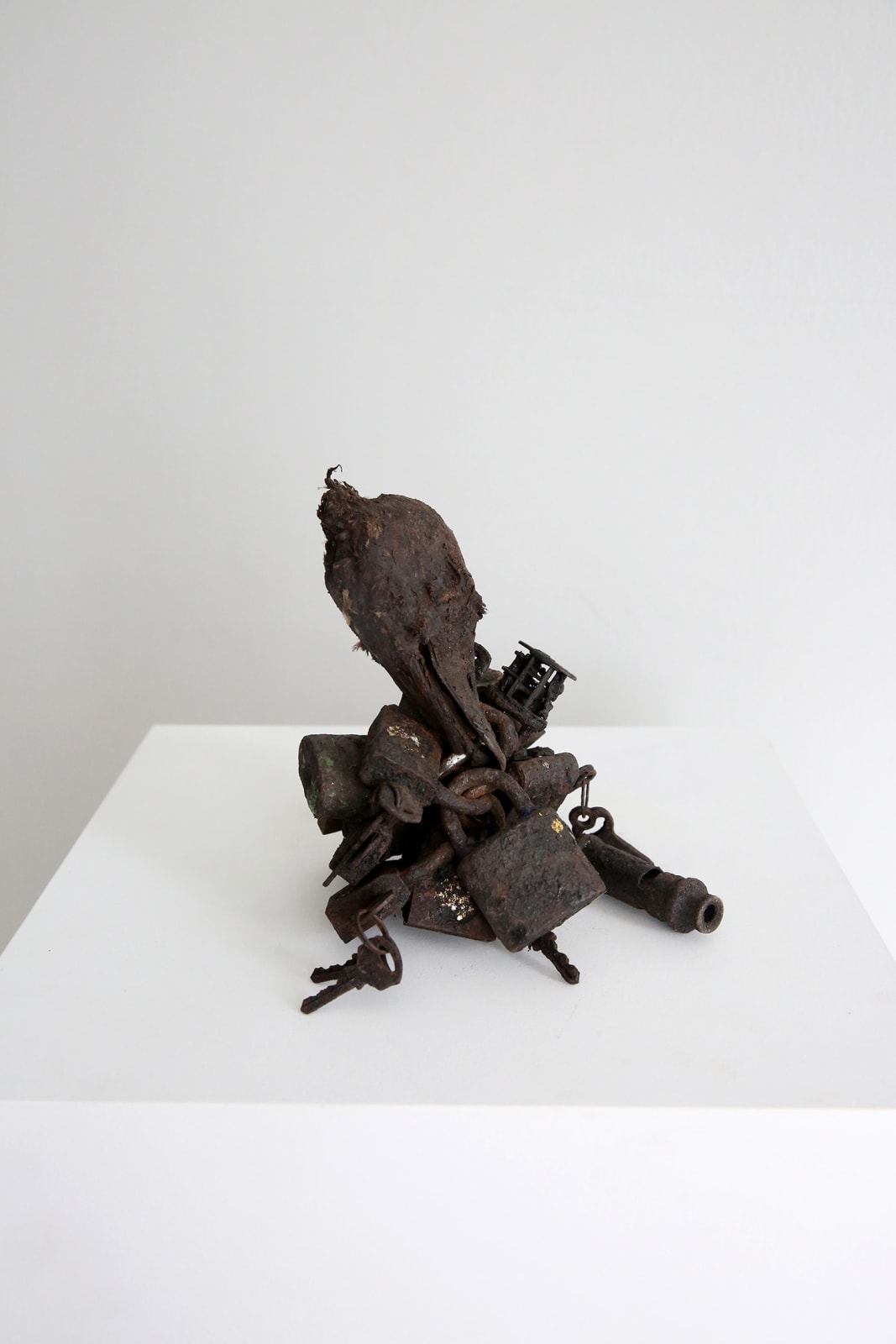Anonymous Fon artist
Duck skull, padlocks, keys, whistle, fibers
height 5 7/8 in
A bocio, literally “empowered cadaver,” is related to Vodun, the Fon people’s religious belief in mysterious forces that govern the world and the lives of those who reside in it. Vodun sculptures not only protected humans but also empowered them and existed in as many shapes and forms as there were issues to be solved. A padlock was a very powerful visual statement; when you put a key in the lock and close it no one would ever be able to open it again. This object was hence associated with ideas of barred access, capture, and containment. A Fon informant of Susan Preston Blier said: “If someone did something to you, and it really troubled you, you will call his name and close the padlock. They you will make a knot and will take the padlock and put in a duck’s bill and all sorts of problems will happen to him. It is this that is called kpodohonme, ‘the stick is put in the door’.” (“African Vodun”, 1995, p. 289) – as in older days instead of padlocks, doors were closed by wooden sticks. As with Kongo power figures, each lock signified a particular wish. Padlocks were objects through which desires were made firm or brought to fruition. “If something is bothering you, one will buy a padlock and come and close the lock”; “one says the thing, and closes the lock. It is what one asks when closing the lock that the bocio will do. If the work is powerful, it will be done” – as Blier’s informants put it (op. cit., p. 291). Bocio with multiple padlocks such as the present example indeed were thought to be more potent than those with but a single example. “If something bothers you, when you close the padlock, nothing more will bother you. When I close it, if someone meets me, he will no longer frighten me” (op. cit., p. 291). Each padlock thus could be identified with a distinct desire of fear which the object was assumed to help promote or negate. All bocio were activated by some form of supernatural force, powers whose vitality was incorporated into the sculpture during their activation – often using offertory blood. The dried black crusty patina that covers this power object is the remnant of these libations with sacrificial blood. This accumulation also includes a metal whistle – said to have been associated with the police and their ability to call and stop citizens (op. cit., p. 414) and thus perhaps strengthening the pleas of the owner of this particular power object. Bocio frequently incorporated animal parts. A certain typical behavior became the key component of the desired association. In this case, the duck’s constant quacking being a universal nuisance proved an easily understood connotation in combination of the closing of its bill. Indeed, bocio of a padlock closing a duck’s bill have also been called aglankpé (literally meaning “you can’t speak”) and evoked silence. “Once the bill of the duck is closed, you can’t speak anymore, it represents the silence of man before dying. It’s a very strong composition. Once the wish is accomplished, it is absolute silence; nothing can come out of this mouth.” (D. Bourdé, “Fétishes de l’ancienne Côte des Esclaves”, 2014, p. 244). This awe-inspiring objets thus presents a striking visual metaphor of silencing an enemy.
Provenance
Private Collection, UK, 2014
Bruno Claessens, Antwerp, Belgium, 2014-2023
Duende Art Projects, Antwerp, Belgium, 2023
let's keep in touch
Join our community & never miss out on a DUENDE moment from now on
* denotes required fields
We will process the personal data you have supplied to communicate with you in accordance with our Privacy Policy. You can unsubscribe or change your preferences at any time by clicking the link in our emails.
